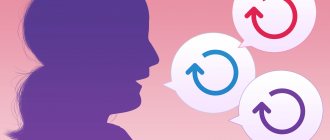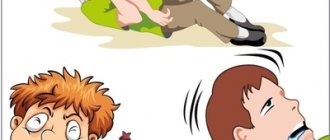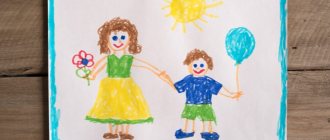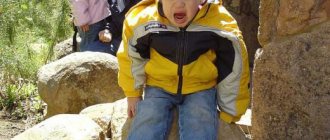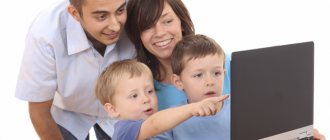Autism is a disorder of mental and psychological development in which there is a deficit of emotional manifestations
Autism spectrum disorders are characterized by deficits in the areas of communication and communication. Translated, the word “autism” means a person directed inward, withdrawn into himself. Depending on the form and degree of autism, cognitive abilities may be reduced or preserved.
Autism or autism spectrum disorder is often replaced by the acronym (ASD). ASD belongs to a group of neurodevelopmental disorders.
In simple words: “ Autism
is a disorder of mental development that manifests itself as a deficit in social interactions. In autism spectrum disorders, there are repetitive behaviors and a limited range of interests.”
What is autism
Autism is a congenital disorder of psychological development that affects a person’s understanding and perception of the world around him and affects relationships and communication with other people⁴.
Are children with autism sick or special?
“First of all, these are children. As for the “sick” or “special” moment, when you hear the phrase “my child is sick” from a mother, as a rule, such a targeted address implies the infectious nature of the disease (for example, ARVI). It is necessary to take into account that parents perceive information about the presence of a mental disorder in a child ambiguously (including extremely negatively, as evidenced by numerous media resources that “collect” patient reviews about the work of a particular doctor). Taking into account the various nuances that a practicing doctor encounters everywhere (for example, moral and ethical standards, client focus, etc.), it is permissible to use the term “child with special needs.” In any case, in the structure of interaction between doctor and patient, the tactics for monitoring children with autism remain unchanged, regardless of the chosen terminology.”
Bugaisky Stanislav Evgenievich
expert
Clinic "Be Healthy"
The International Classification of Diseases (ICD-10) states that this group of disorders is characterized by deviations in communication skills, social interaction, as well as a limited range of interests and range of actions².
Autism spectrum disorders (ASD) are diagnosed in 18–19 children of primary school age out of 1000.3 The number of adults with autism is much smaller and accounts for less than 1% of the population in different countries³. Although it seems that there are not many people with this condition, there has been a steady increase in the number of cases of autism, thanks in part to developments in diagnostic methods.
Initially, autism was called only a symptom - a disorder in the interaction of a person with objects in the environment. Now this term is used to describe a number of independent pathologies: autism itself (childhood autism, classical autistic disorder) and a whole range of similar disorders (atypical autism, Kanner syndrome, Asperger syndrome).
Children of the rain
In 1988, the American feature film Rain Man was released. It described the story of two brothers - the cynical Charles and Raymond, who suffered from autism. Since then, autistic children have been called “rain children.” On December 18, 2007, the UN General Assembly established World Awareness Day, which is celebrated annually on April 2.
Features of the course of the disease
Children with autism have a very difficult time mastering everyday skills that everyone takes for granted. Eating normally is difficult. They are extremely selective and picky when it comes to food. For example, a child eats only semolina porridge, and no variety of dishes will convince him to try something else. If there is no porridge, he will starve. In the end, his mother will cook it and feed him.
The toilet is another problem. Children do not see the point of going to the potty, and cannot understand why adults persistently strive for this. This happens because from early childhood they have a very weak (or no) reaction to such stimuli as:
- cold;
- wet diapers
- hunger;
- unpleasant odors;
- touch.
In play activities, toys are most often completely ignored. Instead, the child prefers to use household items. There is usually no plot of the game; only stereotypical movements are observed, such as spinning in the hands or moving from place to place. An autistic person may sniff, touch, lick a new object for a long time, move it in front of his eyes, or crawl on his knees around it.
Due to speech impairment, it is almost impossible to conduct a dialogue with the patient; he simply will not support it. However, the baby can remember fairly long phrases from films and television shows and reproduce them accurately. When you contact him with a question, he may repeat it or not respond at all.
Causes of autism in children
The human brain consists of several structural sections, and each of them performs specific functions. Autistic people often experience changes in the structure of individual brain structures - the cerebellum, medial temporal lobe, hippocampus and frontal lobe cortex of the cerebral hemispheres. These departments are responsible for learning and remembering new information, expressing emotions, enjoying communication with others and social activity.
An interesting fact: in mammals, damage to these parts of the brain causes similar symptoms - the inability to recognize danger, quickly adapt to a new environment, and refusal to communicate with other animals.
Scientists cannot yet talk about the exact reasons that provoke changes in the listed brain structures - the nature of the disease and the mechanism of its development remain unknown⁴.
Causes of autism
“In most cases, children with autism are satisfactorily developed physically, have a pleasant appearance, in a word, by their external features it is not possible to accurately say about the presence of any disease. The exact causes of its formation are not fully known, but a number of factors have been identified that contribute to the development of autism:
- violations at the level of genes, molecules that store information about how the human body should develop;
- the results of the interaction of genetic factors and environmental factors in which the child develops;
- ecology;
- disruption of intrauterine development of the fetus, fetal hypoxia during pregnancy and during childbirth, infectious diseases during pregnancy (for example, rubella, cytomegalovirus), toxic effects on the fetus (for example, medications taken by the mother during pregnancy).”
Bugaisky Stanislav Evgenievich
expert
Clinic "Be Healthy"
Today, the most likely cause of ASD is considered to be a hereditary predisposition. In 3–7% of cases, relatives of children with autism are diagnosed with similar diseases and other mental and psychological disorders:
- low need for contact with other people;
- speech disorders;
- obsessive behavior;
- mental retardation;
- epilepsy.
In addition, in 90% of cases, autism develops simultaneously in both identical twins. This fact also indicates the hereditary nature of the disease.
Scientists have even been able to identify which genetic mutations cause a predisposition to autism. But don’t worry in advance: the presence of “breakdowns” in the genetic code does not mean that the child will necessarily have ASD, but only increases the risk of developing the disease.
Confirmation of a genetic predisposition to autism was an important discovery, which made it possible to relieve parents of responsibility for the development of such mental disorders in their children. After all, the cause of a child’s abnormal isolation was previously called a lack of parental attention, care and affection.
Risk factors
There are suggestions that the manifestation of autism is associated with certain risk factors, although these have not been confirmed by reliable sources. These include:
- the birth of a child from late pregnancy;
- intrauterine development disorders;
- unfavorable environmental conditions;
- radiation exposure;
- “failures” in metabolism;
- disturbances in the production of thyroid hormones;
- brain pathologies - encephalitis, traumatic brain injuries (Fig. 1).
Figure 1. Risk factors for autism. Source: Autism Connect
Vaccinations and autism: is there a connection?
In 1998, an article by physician Andrew Wakefield was published in The Lancet. In it, the author described several cases in which children developed intestinal lesions and symptoms of autism after vaccination with the rubella, measles and mumps vaccine (MMR vaccine). The author suggested that it was vaccination that became the “trigger” for the development of ASD. However, further research has not found a relationship between autism spectrum disorders and the MMR vaccine. But it was found that Dr. Wakefield received a large sum of money from his patients' lawyers, and also applied for a patent for his own vaccine. As a result, The Lancet decided to retract the publication, and Dr. Wakefield was stripped of his medical license.⁵
The myth about post-vaccination
There is an opinion that autism develops in a child after vaccination of young children. However, such a theory has absolutely no evidence base. Many scientific studies have been conducted, and none of them have found a connection between vaccination and the occurrence of the disease.
It may happen that the time when the child was vaccinated simply coincided with the moment when the parents noticed the first signs of autism. But not more. Misconception in this matter led to a sharp decrease in the level of vaccination of the population, and as a result to outbreaks of infectious diseases, in particular measles.
Classification
Diseases with characteristics similar to autism are usually grouped under the term “autism spectrum disorder” (ASD).
Symptoms of diseases that are included in ASD vary in intensity and affect the lives of patients to varying degrees (Table 1). Table 1. Diseases that are classified as autism spectrum disorders
| Disease | Characteristic |
| Asperger's syndrome | People with this condition adjust better to functioning in society than those with autism. They have less pronounced speech impairments. Patients with Asperger's syndrome are often perceived by others as insensitive, but in reality this is not the case. In many cases, they understand the emotions of others and are capable of empathy, but they cannot realize their feelings in practice. |
| Classic autism (Kanner syndrome) | It is characterized by disturbances in the social development of the child, while his physical development remains normal. The first signs become noticeable already in infancy. The baby does not develop a “revival” complex upon contact with his mother. As the child gets older, he prefers to be alone. His games are stereotypical, for example, he lays out cubes in one line or monotonously turns the wheel of a car for hours |
| Nonspecific pervasive developmental disorder (atypical autism) | Characteristic signs of pathology:
|
| Rett syndrome | A hereditary disease that occurs in girls and leads to the development of severe mental disability. The psychomotor development of a baby up to 6–18 months corresponds to its age. Then the acquired social, motor and speech skills begin to disappear. The face takes on a “lifeless” expression, convulsive seizures are possible |
| Childhood disintegrative disorder (Heller syndrome) | Until the age of two, the child develops normally. Subsequently, he loses previously acquired skills and develops irreversible and severe mental disability. |
| High functioning autism | This form of the disease is characterized by an IQ level of more than 70, so the cognitive abilities of such children are assessed as “highly functional.” Many authors do not identify this type of ASD as a separate pathology, but consider it one of the variants of Asperger's syndrome |
All ASDs are divided by severity - for this purpose, the degree of impairment of communication, behavior and social interaction is assessed.
Mild forms of autistic disorders include:
- high functioning autism;
- Asperger's syndrome;
- atypical autism without mental retardation.
These forms of pathology can be corrected - with properly selected therapy, children can easily study in regular schools and universities, master any profession and achieve self-realization in life.
Severe ASDs include:
- Kanner syndrome (“classic” autism);
- Rett syndrome;
- Heller's syndrome;
- atypical autism with mental retardation.
Severe forms of autism have a greater impact on the lives of patients. People with such pathologies are rarely accepted in society, so they need special rehabilitation programs and constant behavior correction.
Preventing autism during pregnancy
“It is possible to reduce the risk of having a child with autism in families that already have such a child.
Today, one of the proposed measures that can be easily implemented and widespread is pregnancy support by a medical psychologist - in families at risk of having a child with autism. It is in his power to help create an optimizing atmosphere around the pregnant woman and protection from possible manifestations of hereditary inclination. But we should not forget that the proposed measures are not 100% able to prevent the birth of a child with autism.” Bugaisky Stanislav Evgenievich
expert
Clinic "Be Healthy"
Testing a child at home
You can detect the presence of autism in a child at home using various tests. At the same time, you should know that test results alone are not enough to make a diagnosis, but this will be another reason to contact a specialist. There are many tests designed for children of a certain age:
- testing the child on general development indicators, intended for children under sixteen months of age;
- M-CHAT test or modified autism screening test, for children sixteen to thirty months;
- The CARS Autism Rating Scale is used to test children aged two to four years;
- The ASSQ autism screening test is available for children aged six to sixteen.
M-CHAT test or modified autism screening test
Questions:
- Does your baby enjoy being rocked on your lap or in your arms?
- Does the child show interest in other children?
- Does your child like to use objects as steps and climb up them?
- Does your child like to play hide and seek?
- Does the child imitate actions during play (pretend to be talking on the phone or rocking a doll)?
- Does the child use the index finger when necessary?
- Does he use his index finger to emphasize his interest in some action, object or person?
- Are the toys used by the child for their intended purpose (rolling cars, dressing dolls, building forts from blocks)?
- Has the child ever focused on objects that interested him, bringing them and showing them to his parents?
- Is the child able to maintain eye contact with adults for more than one or two seconds?
- Has your baby ever shown signs of hypersensitivity to acoustic stimuli (asking to turn off the vacuum cleaner, covering his ears when listening to loud music)?
- Does the child respond to smiling?
- Does the child repeat the movements, intonation and facial expressions of adults?
- Does the child respond when his name is called?
- When pointing to an object or toy in the room, will the child look at it?
- Can the child walk?
- If you look at any object, will the child repeat your actions?
- Have you noticed your child doing unusual things with his fingers near his face?
- Does the baby try to attract attention to himself and his actions?
- Does your child appear to have a hearing problem?
- Does the child understand what the people around him are talking about?
- Have you ever noticed your baby wandering aimlessly or doing things automatically, giving the impression of complete absence?
- When meeting strangers or encountering incomprehensible phenomena, does the child look into the parents' faces to observe their reaction?
Transcript of the test
For each test question you should answer “Yes” or “No”, and then compare the results obtained with those given in the transcript:
- No.
- No (critical point).
- No.
- No.
- No.
- No.
- No (critical point).
- No.
- No (critical point).
- No.
- Yes.
- No.
- No (critical point).
- No (critical point).
- No (critical point).
- No.
- No.
- Yes.
- No.
- Yes
- No.
- Yes.
- No.
Best materials of the month
- Coronaviruses: SARS-CoV-2 (COVID-19)
- Antibiotics for the prevention and treatment of COVID-19: how effective are they?
- The most common "office" diseases
- Does vodka kill coronavirus?
- How to stay alive on our roads?
If the answers to three ordinary points or two critical ones coincide, then such a child should be consulted by a specialist.
Signs and symptoms of autism in children
The degree of manifestations of ASD varies from person to person. The disorder may manifest itself as subtle social oddities or a narrow range of interests, or it may cause severe mental impairment or a lack of any ability to connect with other people. Basically, the disease occurs without severe impairment of mental activity, and in almost 50% of children with autism, intellectual abilities are assessed as average or even above average.
Often, a diagnosis of autism not only does not affect mental abilities, but even helps such patients reveal their intellectual and creative potential. There are many successful autistic people in the world who have become famous scientists, composers, writers, and directors. There is evidence that Wolfgang Amadeus Mozart, Albert Einstein, and Charles Darwin had behavioral disorders that resembled symptoms of autism. Also, according to data from various sources, from 5 to 20% of programmers-employees of Microsoft Corporation are people with autism spectrum disorders⁹.
As a rule, the symptoms of autism in children form a typical triad:
- Violations of social interaction - narrowing of the range of interests and difficulties in perceiving new information.
- Anomalies in communication - difficulty communicating with people around you.
- Stereotypical patterns - persistent repetition of words and/or phrases, movements.
Children with ASD cannot bear the usual loads of any healthy person. They perceive everything around them much brighter and stronger, especially close contacts with other people. Despite this, at any age, autistic children do not try to “close themselves” in their inner world. They expect understanding from others, and their desire to communicate is often even stronger than that of ordinary children.
At the same time, patients with autism are not able to fully understand the emotional state of others, since they do not understand non-verbal signals - communication through facial expressions, gestures, and voice intonation. This prevents them from forming meaningful relationships with others, and the lack of social interaction is the most striking of all symptoms of autism in children (Figure 2).
Figure 2. Some signs of autism in children. Source: Sonulkaster / Depositphotos
Signs of autism in infants
In infants, behavioral problems are not as obvious.
But with careful observation of the child, parents may notice some symptoms of autism in the first year of his life. Most often, they begin to appear after six months of age and, at first glance, resemble some kind of developmental delay (Table 2). Table 2. Signs of autism spectrum disorder in children under 6 months of age
| Normal development | Development in ASD |
| Confidently rolls over from stomach to back and vice versa, sits with little support, begins to crawl | Doesn't try to crawl, but rocks on his knees and elbows |
| Reaches for a toy, confidently transfers it from one hand to another, tastes it | Shows no interest in toys, does not strive to pick them up or perform any purposeful actions with them |
| Reacts well to sounds, turns his head in their direction | Does not respond to sound if it does not see its source |
| Confidently pronounces sounds or syllables - the “humbling” begins | There is no “humming” of syllables, the voice while screaming is low, hysterical |
| Cries only for reasons, easily distracted from negative emotions | Irritable, often cries for no reason |
| He rejoices at the sight of loved ones, reaches out to them, asks to be held in his arms. Tries to imitate the actions of adults | Has difficulty recognizing loved ones, does not ask to be held, does not try to imitate. May fixate on adults' faces, but never makes eye contact |
Signs of autism in children under 1 year of age are nonspecific. Based on them, one can only suspect a disease, but the same symptoms may indicate developmental delay and other pathologies of the nervous system.
In ASD, motor and speech skills are formed in a normal sequence, but with a slight delay. A child under one year old may be unsure of holding toys or not using a spoon, but as a result of special classes he quickly learns these skills and catches up with his peers.
Early signs of autism
“It is possible for parents to see the first manifestations of autism in a child up to one year of age.
During the first months of life, children with autism show less interest in bright toys, they are less mobile, and they have poor facial expressions. As they grow up (at the stage of 5-6 months), children with autism have practically no interest in the objects around them, they do not try to grab objects and manipulate them, against this background, muscle tone corresponds to physiological parameters.” Bugaisky Stanislav Evgenievich
expert
Clinic "Be Healthy"
The ability to hold toys and the desire to reach for them is an important marker of infant development. Photo: tetenio / freepik.com
Signs of autism in children aged 1–2 years
Signs of autism in 2-year-old children become more pronounced.
During this period, not only specialists, but also people around may notice some strange behavior (Table 3). Table 3. Signs of autism spectrum disorder in children aged 1.5 - 2 years
| Normal development | Development in ASD |
| Walks confidently. Drinks from a cup and eats with a spoon independently | Walks unsteadily or jerkily. “Stereotypes” appear - aimless repetition of movements, for example, rotation around its axis, jumping in place, prolonged waving movements with a brush. |
| Uses several dozen words in speech. Able to show body parts correctly. Knows the purpose of many objects, can find them by name | The child senselessly repeats words that he hears in someone else’s speech. Doesn't try to reach out to other people or start a conversation |
| Able to ask for help using words, gestures, facial expressions | Instead of asking for help, simply state your needs |
| Loves to sit on laps. Copies well the actions of adult family members. Plays well with toys. Story elements are starting to appear in games | Strives for a constant environment. Adults either reject help or, conversely, become overly dependent on it. The games are simple, completely devoid of meaning and plot. |
At two years of age, children with autism do not participate in play with their healthy peers. Most often, they ignore those around them - both strangers and relatives.
By the age of 2, a child can usually use a spoon and drink from a cup independently. Photo: lenamay / freepik.com
Signs of autism in children aged 3
Signs of autism in children aged 3 are usually very pronounced. The games of healthy children over three years old become quite complex - they involve imagination and distribute social roles. Autistic children aged 3 years and older perceive toys solely as physical objects and do not try to “bring them to life” through imagination. They can sit alone for hours and perform one task for a long time, for example, turning a car wheel or lining up blocks in a row.
Signs of autism in children aged 4
At four years old, children begin the “age of questions.” They actively explore the world around them and try to understand the essence of many phenomena. A child with ASD does not ask his parents questions about how the world works—their questions are devoid of practical meaning.
At the age of 4, children with autism become noticeably delayed in speech development. They often repeat the same phrases and words, talk about themselves in the third person, and react poorly to other people's speech. In severe forms of the disorder, speech may be completely absent.
The main sign of autism in a 4-year-old child is stereotypical behavior when he becomes fixated on carefully performing certain daily rituals. Moreover, if the sequence is even slightly disrupted, he may respond with a strong negative reaction - crying, aggression, resentment.
Children with autism often exhibit other signs:
- seizures;
- attention deficit disorder;
- unexpected reactions to ordinary stimuli - lighting, sound, touch;
- refusal to eat or dislike of certain foods;
- night awakenings, difficulty falling asleep.
It was previously believed that children with autism were unable to form emotional bonds with loved ones. It has now been established that this is not the case - if a child is left alone, he develops signs of anxiety, although he does not try to call mom or dad. Autistic people feel more confident and calm around their parents, although this may not be noticeable to others.
A child with autism is often a small eater and may eat the same thing every day, preferring strictly certain foods. Photo: Dudaeva / Depositphotos
Therapy and training
During special classes for preschoolers at the Neuropsychiatric Institute of the University of California: an autistic child points at aquarium fish. Researchers are trying to evaluate the effects of intensive training with a focus on joint attention on language development.
The main goals of therapy are to reduce autism-associated deficits and tension in the family, improve the quality of life and functional independence of the autistic person. There is no single optimal treatment method; it is usually selected individually. Methodological errors made when conducting studies of different therapeutic approaches do not allow us to speak with confidence about the success of a particular concept. Some improvements have been observed with many psychosocial interventions; this suggests that any help is better than no help. However, the methodology of systematic reviews remains poor, the clinical results of interventions are largely unclear, and there is a lack of data on the comparative effectiveness of approaches.
Intensive, long-term special education and behavioral therapy programs early in life can help a child develop self-help skills, communication skills, job skills, and often improve level of functioning and reduce the severity of symptoms and maladaptive behavior. Claims that support is particularly important around age three are not supported by evidence.[ Available approaches include applied behavior analysis, develompental models, structured learning (TEACCH), speech therapy, social skills training , occupational therapy. Within the framework of applied behavior analysis, several approaches have been identified specifically for children with autism and autism spectrum disorders: discrete trial training, pivotal response treatment, spontaneous learning and applied speech behavior ( English applied verbal behavior.To some extent, children benefit from such educational interventions: intensive use of applied behavior analysis has improved the overall level of functioning of preschool children, and has been well established as a method for increasing the intellectual performance of young children. Neuropsychological data is often poorly communicated to teachers, which creates a gap between recommendations and the nature of teaching.It is unknown whether programs for children lead to significant improvements after they grow up, and the scant research on the effectiveness of adult community-based programs suggests mixed results.
To control autistic symptoms when behavioral intervention is unsuccessful, when manifestations of the disorder do not allow the child to integrate into the school community or family, a wide range of medications are used. Thus, in the United States, more than half of children with autism spectrum disorders receive psychotropic or anticonvulsant medications, with antidepressants, stimulants, and antipsychotics most often prescribed. With the exception of the latter, the effectiveness and safety of the use of various drugs for autism spectrum disorders is extremely poorly reflected in high-quality scientific publications. In a person with the disorder, medications may cause atypical reactions or adverse side effects, and no known medications have been shown to alleviate key communication and social problems in autism.
Due to communication difficulties, autistic children are often unable to communicate the side effects of psychotropic medications, and the discomfort they experience as a result of these side effects may manifest as an increase in the very pathological behavior that is being treated. Studies have shown a high risk of developing extrapyramidal side effects of antipsychotics in autistic children, in particular tardive dyskinesia. Neuroleptics are not advisable to use in autism, with the exception of only the most severe cases of uncontrolled behavior - with a pronounced tendency to self-harm and aggressiveness, resistant to other interventions (in cases where behavioral therapy, correction of existing neurological and somatic disorders, mood stabilizers and antidepressants were ineffective).
Although a wide range of alternative approaches and techniques are available, few have been the subject of scientific research.] Outcome data from such approaches are rarely linked to quality of life measures, and many programs use measures that lack predictive validity and are far removed from reality. Organizations offering services to parents of autistic people, when choosing methods, seem to be guided primarily not by scientific data, but by the marketing offers of program authors, the availability of training for their employees, and the requests of parents. Although most alternative methods, such as using melatonin, cause only minor side effects, some may pose risks to the baby. Thus, a 2008 study showed that, compared with their peers, autistic boys on a casein-free diet had thinner bones. In 2005, inadequately administered chelation killed a five-year-old autistic child.
Treatment costs for autism are high; indirect losses are even higher. According to a US study, the average lifetime cost for a person with autism born in 2000 would be $3.2 million in 2003 purchasing power, with about 10% spent on medical care and 30% on additional education and care, and losses in economic productivity will account for the remaining 60%. Programs funded by grants and donations often do not address the needs of the individual child, and parents' unreimbursed out-of-pocket costs for medications and other therapies can leave families in financial distress. A 2008 US study found that the average annual income loss of a family with an autistic child was 14%, and another related publication found that the challenge of caring for a child with autistic disorder can have a significant impact on a parent's work life. . Once adulthood is reached, issues of community care, vocational and job search, sexual relationships, the use of social skills, and estate planning come to the fore.
Complications of autism
People with ASD often have difficulty choosing a profession and finding employment. The inability to adequately express emotions leads to them laughing, crying or screaming for any reason or even for no specific reason. This becomes a serious barrier to communication with members of any team. In addition, even minor impairments in intellectual activity in such children can become a reason for ridicule in the company of peers.
Children with ASD may show aggression not only towards other people, but also towards themselves. They cause serious harm to themselves, so they should always be under adult supervision.
Autism spectrum disorders are often accompanied by other disorders:
- epilepsy;
- anxiety states;
- depression;
- attention deficit hyperactivity;
- sleep disorders.
One of the most serious complications of pathology is social maladjustment and disability. Adult patients can live without assistance only with mild forms of autism. Often, due to the severe consequences of the disease, people with ASD end up in a psychoneurological boarding school.
Autism and digestive problems
Unusual tastes in food and selectivity when choosing foods in autistic people often provoke the development of diseases of the gastrointestinal tract, hypovitaminosis, anemia, constipation or, conversely, diarrhea, when undigested pieces of food can be seen in the stool. Refusal to eat and poor diet negatively affect intestinal motility and deprive the child of essential nutrients, aggravating the condition.
When should you suspect autism?
Speech impairments and a high pain threshold in children with autism create serious problems in timely diagnosis. Autistic people are often unable to complain of pain or describe the symptoms of the disease, so they see a doctor in the late stages of pathologies with serious complications that can even be life-threatening.
To prevent such a situation, it is important for parents to carefully monitor the development of the child from the moment of his birth. You should consult a doctor to rule out autism spectrum disorder if your child:
- avoids eye to eye contact;
- does not respond to his own name;
- does not know how to play with toys;
- does not respond to instructions from adults;
- does not smile;
- does not communicate his desires;
- shows indifference or aggression.
There are other signs that should alert parents and become a reason to consult a neurologist (Fig. 3).
Figure 3. What parents should be wary of in their child’s behavior. Source: MedPortal
Manifestations of autism by age group
If the disease is not accompanied by any additional diagnosis, an outwardly autistic child may be no different from other children.
Children from 0 to 2 years. The following symptoms will help recognize autism in children under 2 years of age:
- Doesn't smile, doesn't gesticulate, doesn't chatter, and often fixes his gaze in one place. If you try to make a grimace, he will not react to it;
- Plays quietly for a long time;
- In particularly severe forms of the disease, the above symptoms may be accompanied by convulsions and attacks of epilepsy.
Children from 2 to 7 years old. During this period, the diagnosis of “early childhood autism” is most often made. In addition to the signs described above, you can add the following symptoms of childhood autism:
- In order to avoid any contact, the child tries to independently learn to take care of himself and does not ask for help in everyday affairs;
- There doesn’t come a time when the baby asks the question “why?” This is due to speech impairment;
- May be hyperactive. It is difficult for them to sit still and concentrate on one thing;
- They are distinguished by a special gait: they walk on tiptoes, or sway left and right. Children often have poor coordination of movements, and it is difficult for them to learn to walk up the stairs or hit a soccer ball;
- Autistic people are fearful. Moreover, he is often frightened by completely unexpected things;
- Picky eaters. Autistic people like a certain set of foods. These tastes are formed in early childhood and throughout life;
- Digestive problems. They are associated with brain disorders. The brain does not receive signals from the digestive system, which leads to problems;
- Sleep problems. The baby does not distinguish between day and night, and his activity level does not depend on the time of day. Therefore, it is difficult to put him to sleep. He wakes up frequently at night and sleeps an average of 7 hours or less per night. With increased fearfulness and hyperactivity, he may suffer from nightmares and insomnia.
Children of school age and older
- Selectivity in objects. Autistic people fail in all subjects. But they can show phenomenal abilities in one of them. For example, multiplying multi-digit numbers in your head, or, having read a literary work once, immediately retell it;
- Nonverbal expression of feelings. Such children are silent, so they often express their feelings through drawings, music or poetry. Poems that autistic people write often make no sense to others;
- Difficulties during puberty. If a person does not receive proper therapy in childhood, then during puberty he can become depressed and even show aggression. He feels that he is not like everyone else and at this age he may begin to suffer.
Diagnosis of autism in children
A neurologist may suspect autism based on characteristic symptoms. To confirm the diagnosis and assess the severity of the pathology, various neuropsychological techniques are used:
- Autism Diagnostic Observation Schedule (ADOS) - used in children of any age and with different levels of development. This scale consists of four blocks that allow you to assess a child’s ability to play complex games, his communication skills and speech development.
- Childhood Autism Rating Scale (CARS) - suitable for diagnosing characteristic disorders in children from 2 to 4 years old. The scale evaluates various types of perception (tactile, olfactory, gustatory, visual), dexterity of movements, ability to imitate, emotional reactions, cognitive activity.
- The Modified Checklist for Autism in Toddlers (M-CHAT) is a test for parents. It contains 20 questions that relate to the child’s behavior in various situations.
- Autism Spectrum Screening Questionnaire (ASSQ) is a test for diagnosing various types of autism spectrum disorders in children from 6 to 16 years old⁸.
To exclude other pathologies, children must undergo instrumental studies of the brain - tomography (CT, MRI), electroencephalography (EEG)⁸.
Important!
In children under one year of age, the reliability of the diagnosis of autism does not exceed 50%. This means that in the future it is confirmed only in every second baby. The likelihood of correctly identifying ASD increases with age, and most children are correctly diagnosed with autism spectrum disorder between the ages of 2 and 3⁶.
The recipe is simple - give yourself completely
Christopher and Rhona Robertson, with whom we began the story, fearfully await the time when their son becomes a teenager. After all, he will face more and more new difficulties. They are very afraid that his condition will regress and are trying to do everything possible to prevent this.
“The problems are already here, and they need to be solved somehow, which is what we are doing,” says Christopher. “We know we have to teach Jamie the social skills he can’t live without.” There is no magic pill, and our formula cannot be said to work for everyone. My only fear is that other parents, having heard all the unpleasant things about autism that we heard, will give up and will not have the strength to fight. I believe that autism can be cured, you just have to give your whole self to the child.”
Treatment of autism in children
It is impossible to completely get rid of pathology with the help of medications or psychotherapy - mental disorders will accompany a person with autism throughout his life. But with the help of various techniques, it is possible to improve the patient’s condition, teach him self-care skills, and help form and maintain social contacts.
Classes for children with autism are conducted jointly by psychologists, speech pathologists and speech therapists. Only systemic and constant therapy with the involvement of relatives can achieve noticeable positive results.
One of the modern methods is ABA therapy (Applied behavior analysis). It includes various techniques that are aimed at correcting children’s behavior in a social environment and teaching them self-care skills. ABA therapy is based on a reward system, when for every correct action the child receives positive reinforcement - a reward. First, children learn simple actions, and then slowly and gradually combine them into more complex tasks.
It is advisable to start ABA therapy from the age of 3 years. At least 30–40 hours of classes are conducted per week. At the same time, at home, parents must systematically repeat and consolidate the skills acquired during lessons.
Another effective technique is the PECS (Picture Exchange Communication System) system. For these activities, special cards are used depicting various actions and objects. With the help of these cards, children are taught how to approach adult family members with certain requests. Although this technique is not aimed at developing oral language, it does improve speech function in some children.8
PECS technique. Source: StopAutism website
In Russia and the CIS countries, psychologists widely use the emotional-level approach when working with autistic children. It is based on the creation of a trusting emotional contact between a specialist and his patient. And only then does work begin on overcoming aggression, anxiety and fears, and learning purposeful activities.
Drug treatment for autism is rare and is generally indicated only in cases where psychological methods are ineffective. The drugs can reduce the severity of some psychological problems:
- aggressive behavior;
- increased anxiety;
- causeless tantrums;
- hyperactivity syndrome;
- sleep disorders.
Drug treatment improves the child’s behavior when visiting public places and facilitates his participation in family life. But it is important to strictly follow the doctor’s recommendations—the medications should be taken in the shortest possible course. Immediately after achieving the desired effect, the dosage of the drugs is gradually reduced until complete withdrawal. In this case, you cannot self-medicate - this can only harm the child and provoke the progression of the disease.
Education for children with autism
Enrolling a child with autism in kindergarten and school can be a challenge.
In Russia, many such children switch to home-based education, which excludes communication with peers and can negatively affect progress in treatment, as it deprives children of communication practice. Parents should know that, by law, children with ASD have the right to study in any school of their choice (including general education), since they belong to the category of children with disabilities. At the same time, the state must provide them with special conditions that will depend on the degree and severity of their disorder. These may include classes with experienced teachers (speech therapists, psychologists, etc.), an adapted school curriculum, or access to sensory relief equipment, if necessary. One of the most preferred teaching models for children with autism is the resource classroom approach. It involves the gradual introduction of the child into an environment where he can learn together with ordinary children. So far there are not many such classes, and they are often created thanks to the considerable efforts of parents, but progress in the education system for special children can already be seen.
We will enter his world ourselves
Many parents agree with June: over the years, their children’s autism only gets worse, and no improvements in their condition are observed.
Paul Stewart's son Andrew was diagnosed with autism when he was four years old. “While the child is small, his problems may not be noticeable. People often say: “It’s okay, it’ll grow up,” says Paul, a teacher from Glasgow. – Now Andrew is 16, and his problems are visible to the naked eye. After all, people expect more from him than from an 8-year-old child.”
Paul understands parents who don’t want to come to terms with their child’s diagnosis. “They send their children to regular schools in the hope that they will become “like everyone else,” but it never works. Of course, I would like to wave a magic wand and say: “there is no more autism” - but this is impossible.”
Paul and his wife decided not to waste time and money on methods that most likely would not help. They decided to enter Andrew's world themselves and try to make his life as easy as possible.
“Andrew is at his worst in the mornings,” says Paul. – He himself may wear the wrong trousers, forget money for school lunch or his coat, forget to brush his teeth, and so on. So we came up with a checklist for him to live by, and now nine times out of ten he does everything right. But this does not happen because he began to think differently. We simply create the appropriate conditions for it to act correctly. Autism is here to stay, and my son will never be able to do things automatically like, say, me.”
Andrew now goes to a magnet school, but takes football courses at a regular college. He has many friends in the youth group at his local church. His parents believe he will eventually be able to live independently.
“Andrew really wants to be independent, and I can’t be with him forever, so when the time comes, we will place him separately. He will have helpers, he will feel comfortable and gradually get used to life without us,” says Paul.
Prognosis and prevention of autism
Autism is an incurable disease. But timely behavior correction can achieve a significant improvement in the condition. It is believed that speech development before the age of six and a sufficiently high IQ in patients are signs of a favorable prognosis. The course of the disease can be improved through constant exercise, rehabilitation, and the creation of a calm environment within the family.
It is impossible to prevent the development of the disease in your child. But following the rules of a healthy lifestyle and careful monitoring of the course of pregnancy reduce the risk of pathology. To prevent deterioration in their health, it is important for patients with autism to constantly undergo therapy and be observed by doctors of various specialties, and for their parents to create a favorable atmosphere at home and constantly learn to communicate with their children.
Special giftedness of autistic people
“There is such a thing as “savantism” (from the French word “savant”, which translates as “scholar”) - a condition when an autistic child or adult is very gifted in a particular area.
In savants, experts identify amazing mental knowledge or abilities in a certain field of activity. At the same time, in terms of the level of intellectual development, patients stop at the stage of mild mental retardation. Most often, the anomaly occurs due to genetic disorders and can be inherited. The syndrome can also occur due to previous traumatic brain injuries or brain diseases. Many scientists believe that savantism is a consequence of perinatal pathology. All the causes of the anomaly are not fully known, but experts estimate that the disease is five times more likely to affect men than women. This is explained by the fact that the male chromosome contains dozens of genes that contribute to the birth of a child with this disease. Some scientists suggest that the anomaly develops due to a special virus that causes neurons to mutate. The results of MRI and CT scans of the brain prove that in people with savant syndrome, the right hemisphere (“responsible” for creativity, spatial and imaginative thinking) is much better developed than the left hemisphere (“responsible” for analytical thinking, verbal information). This is why autistic people exhibit special abilities.” Bugaisky Stanislav Evgenievich
expert
Clinic "Be Healthy"
The difference between autism and dementia
Autism is often confused with other similar diseases, such as dementia. Indeed, the symptoms of such diseases are quite similar. However, children with dementia differ from autistic children:
- intense emotionality;
- abstract thinking;
- large vocabulary.
Such symptoms are not characteristic of autism, but with this disease, patients may also experience mental retardation.
Sources
- Autism. Wikipedia
- General disorders of psychological development. ICD-10.
- Autism spectrum disorders in childhood: diagnosis, therapy, prevention, rehabilitation. Public organization "Russian Society of Psychiatrists". 2022.
- Early diagnosis of autism spectrum disorders in the practice of a child psychoneurologist. Clinical recommendations of the State Budgetary Healthcare Institution “Scientific and Practical. "Center for Pediatric Psychoneurology" of the Moscow Department of Health. 2014.
- The world before and after the invention of vaccines. Biomolecule
- I.V. Makarov, A.S. Avtenyuk. Diagnosis of childhood autism: errors and difficulties. Social and clinical psychiatry. 2022, vol. 28. No. 3
- Machurina Tatyana Nikolaevna (2016). Childhood autism: diagnosis, therapy, rehabilitation. International scientific review, (20 (30)), 105-108.
- Myasagutova Alina Failovna, Valiullina Gulnara Vladimirovna, & Mukhametzyanova F. G. (2019). Development of speech communication in preschool children with autism spectrum disorders using Pecs. Kazan Bulletin of Young Scientists, 3 (4 (12)), 25-37.
